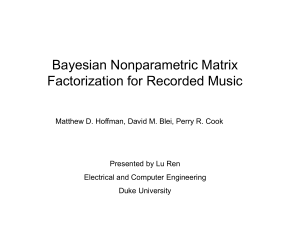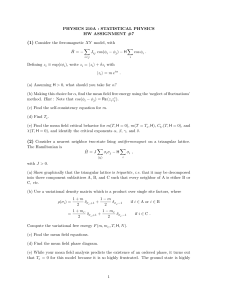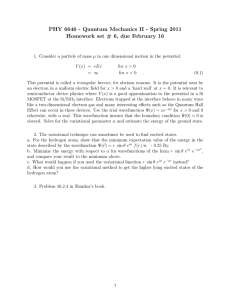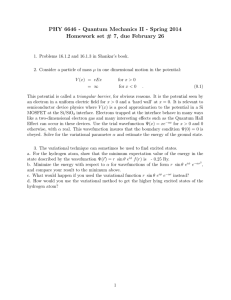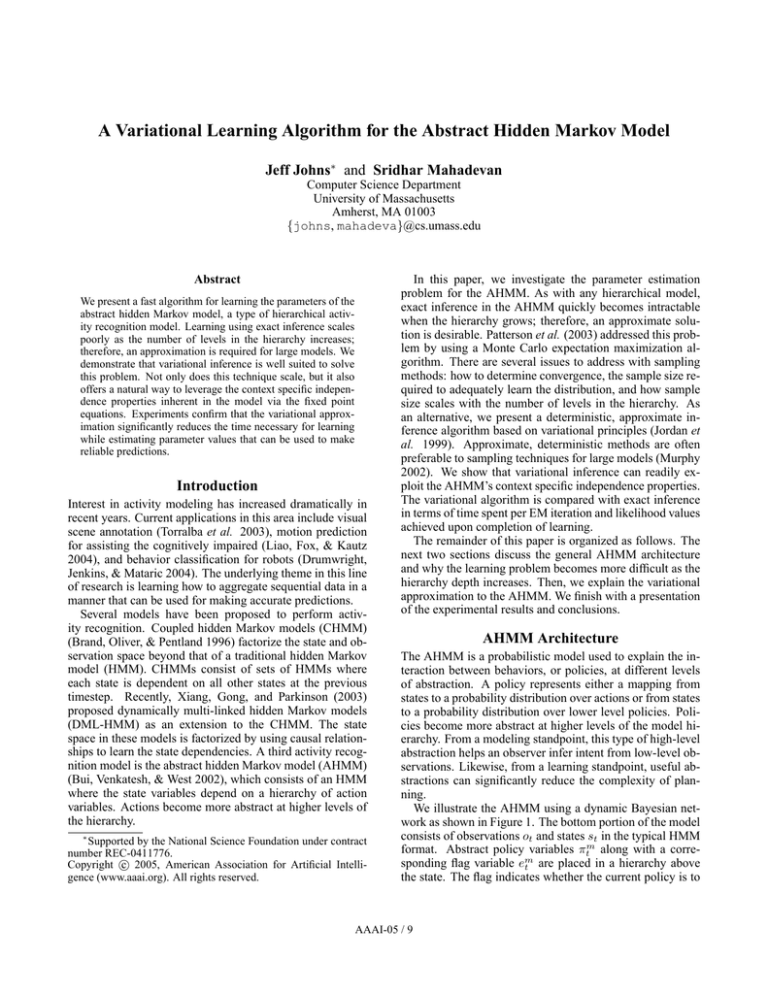
A Variational Learning Algorithm for the Abstract Hidden Markov Model
Jeff Johns∗ and Sridhar Mahadevan
Computer Science Department
University of Massachusetts
Amherst, MA 01003
{johns, mahadeva}@cs.umass.edu
Abstract
We present a fast algorithm for learning the parameters of the
abstract hidden Markov model, a type of hierarchical activity recognition model. Learning using exact inference scales
poorly as the number of levels in the hierarchy increases;
therefore, an approximation is required for large models. We
demonstrate that variational inference is well suited to solve
this problem. Not only does this technique scale, but it also
offers a natural way to leverage the context specific independence properties inherent in the model via the fixed point
equations. Experiments confirm that the variational approximation significantly reduces the time necessary for learning
while estimating parameter values that can be used to make
reliable predictions.
Introduction
Interest in activity modeling has increased dramatically in
recent years. Current applications in this area include visual
scene annotation (Torralba et al. 2003), motion prediction
for assisting the cognitively impaired (Liao, Fox, & Kautz
2004), and behavior classification for robots (Drumwright,
Jenkins, & Mataric 2004). The underlying theme in this line
of research is learning how to aggregate sequential data in a
manner that can be used for making accurate predictions.
Several models have been proposed to perform activity recognition. Coupled hidden Markov models (CHMM)
(Brand, Oliver, & Pentland 1996) factorize the state and observation space beyond that of a traditional hidden Markov
model (HMM). CHMMs consist of sets of HMMs where
each state is dependent on all other states at the previous
timestep. Recently, Xiang, Gong, and Parkinson (2003)
proposed dynamically multi-linked hidden Markov models
(DML-HMM) as an extension to the CHMM. The state
space in these models is factorized by using causal relationships to learn the state dependencies. A third activity recognition model is the abstract hidden Markov model (AHMM)
(Bui, Venkatesh, & West 2002), which consists of an HMM
where the state variables depend on a hierarchy of action
variables. Actions become more abstract at higher levels of
the hierarchy.
∗
Supported by the National Science Foundation under contract
number REC-0411776.
c 2005, American Association for Artificial IntelliCopyright gence (www.aaai.org). All rights reserved.
In this paper, we investigate the parameter estimation
problem for the AHMM. As with any hierarchical model,
exact inference in the AHMM quickly becomes intractable
when the hierarchy grows; therefore, an approximate solution is desirable. Patterson et al. (2003) addressed this problem by using a Monte Carlo expectation maximization algorithm. There are several issues to address with sampling
methods: how to determine convergence, the sample size required to adequately learn the distribution, and how sample
size scales with the number of levels in the hierarchy. As
an alternative, we present a deterministic, approximate inference algorithm based on variational principles (Jordan et
al. 1999). Approximate, deterministic methods are often
preferable to sampling techniques for large models (Murphy
2002). We show that variational inference can readily exploit the AHMM’s context specific independence properties.
The variational algorithm is compared with exact inference
in terms of time spent per EM iteration and likelihood values
achieved upon completion of learning.
The remainder of this paper is organized as follows. The
next two sections discuss the general AHMM architecture
and why the learning problem becomes more difficult as the
hierarchy depth increases. Then, we explain the variational
approximation to the AHMM. We finish with a presentation
of the experimental results and conclusions.
AHMM Architecture
The AHMM is a probabilistic model used to explain the interaction between behaviors, or policies, at different levels
of abstraction. A policy represents either a mapping from
states to a probability distribution over actions or from states
to a probability distribution over lower level policies. Policies become more abstract at higher levels of the model hierarchy. From a modeling standpoint, this type of high-level
abstraction helps an observer infer intent from low-level observations. Likewise, from a learning standpoint, useful abstractions can significantly reduce the complexity of planning.
We illustrate the AHMM using a dynamic Bayesian network as shown in Figure 1. The bottom portion of the model
consists of observations ot and states st in the typical HMM
format. Abstract policy variables πtm along with a corresponding flag variable em
t are placed in a hierarchy above
the state. The flag indicates whether the current policy is to
AAAI-05 / 9
Figure 1: A 2-level AHMM.
continue or terminate in the next timestep. The joint probability of the AHMM with M policy levels is described in
Equation 1 † .
P ({πtm , st , em
t , ot }) =
P (s1 |π11 )P (o1 |s1 )
M
Y
m
m−1
P (π1m |π1m+1 )P (em
)
1 |π1 , s1 , e1
m=1
T
Y
P (st |st−1 , πt1 )P (ot |st )
t=2
M
Y
m
m m
m−1
P (πtm |πt−1
, πtm+1 , em
)
t−1 , st−1 )P (et |πt , st , et
m=1
(1)
Two context specific independence (CSI) properties
(Boutilier et al. 1996) exist in the AHMM. First, a policy
variable either depends deterministically on the policy at the
previous timestep (flag = continue) or it depends on a higher
level policy and the previous state (flag = terminate).
This
πm
relationship is described in Equation 2 where Pcont
is simply an identity matrix of size |π m | × |π m |. Second, a flag
variable is constrained to continue if the flag at the level beneath it has not yet terminated (Equation 3). The CSI properties reduce the number of model parameters, a fact that we
exploit to accelerate the variational approximation.
m
P (πtm |πt−1
, πtm+1 , em
t−1 , st−1 ) =
(
m m
πm
P (πt |πt−1 ) ≡ Pcont
P (πtm |πtm+1 , st−1 )
≡
π
Pterm
m
m−1
P (em
)=
t |πt , st , et
(
m
P (et = continue) = 1
m
m
e
P (em
t |πt , st ) ≡ Pterm
†
m
if em
t−1 = continue
if
em
t−1
(2)
= terminate
if em−1
= continue
t
(3)
if em−1
= terminate
t
Ignore πtm+1 when m = M and ignore em−1
when m = 1.
t
Figure 2: Size of the largest clique during exact inference
versus depth of the AHMM hierarchy.
Difficulty of Learning
Learning the parameters of a Bayesian network with hidden variables is typically carried out using the iterative expectation maximization (EM) algorithm (Dempster, Laird,
& Rubin 1977). The expected value of the log likelihood
is calculated in the E-Step. To do so, one needs to calculate the posterior distribution of the hidden variables given
the observations. It is well known that the computational
complexity of an exact E-Step using the junction tree algorithm is proportional to the size of the largest clique formed
during triangulation of the corresponding Bayesian network.
Unfortunately, the AHMM has a treewidth that increases linearly with the number of policy levels in the hierarchy. This
results in large cliques which cause the E-Step to become
computationally intractable.
To illustrate this problem, consider a generic AHMM
where the depth of the hierarchy is varied from 1 level to 15
levels. We assume the number of values a policy node can
take on decreases exponentially as you move up the policy
hierarchy (i.e. 100 potential policy values at level 1, 10 policy values at level 2, etc . . . ). We then employ the heuristicbased triangulation methodology described in Huang and
Darwiche (1994) to determine the maximum clique size for
each AHMM. Figure 2 shows empirically that the maximum
clique size increases linearly with the number of levels in the
hierarchy. If the maximum clique size is 10 and the average
number of policy values is 4, there would be greater than
one million entries for the potentials in the maximal clique.
Thus, exact inference using the junction tree algorithm is not
computationally feasible for any nontrivial hierarchies.
To speed up learning, an approximate inference algorithm
must be used in the E-Step. The next section discusses the
mean field approximation. The concept behind the approach
is very simple. Removing edges from the full AHMM avoids
the problem of forming large cliques.
AAAI-05 / 10
Figure 3: Mean field variational approximation of the 2-level
AHMM.
and the variational distribution in order to attain the tightest
lower bound on the log likelihood of the data. The updates
are done by taking the derivative of the KL divergence with
respect to the variational parameters, setting the result to
zero, and solving for the variational parameters. This yields
the fixed point equations.
m
As an example, we show the fixed point equation for hπt
for 1 < t < T and 1 < m < M in Equation 5. We abuse
the notation in this equation for the sake of readability. The
variational parameters are vectors and the transition models
are multi-dimensional matrices. Rather than using summations to index into each vector, we leave the equations in
a vectorized format with the understanding that the vectors
need to be handled appropriately. Also, the symbol ϕ represents the softmax operator which ensures the variational
parameter vector sums to one.
Variational Approximation
Model
We consider a completely factorized variational approximation to the AHMM (Figure 3). The joint distribution for this
model is shown in Equation 4. This mean field approximation is inspired by Ghahramani and Jordan’s (1997) approximation of the factorial HMM.
m
hπt
m
π
e
s
Q({πtm , st , em
t }|{ht , ht , ht }) =
T
Y
Q(st |hst )
t=1
M
Y
m
m
e
Q(πtm |hπt ) Q(em
t |ht )
By assuming all variables are independent, the only parameters for this distribution are
the variational
parameters.
m
m
The variational parameters {hπt }, {het }, and {hst } are the
means of the policy, flag, and state variables respectively.
As such, each parameter determines the probability of the
variable taking on each of its possible values.
Inference
The variational approximation is used to form a lower bound
on the log likelihood of the data under the full AHMM. This
is proven using Jensen’s inequality.
X
P ({πtm , em
t , st , ot })
{πtm ,em
t ,st }
≥
X
Q({πtm , em
t , st }) log
{πtm ,em
t ,st }
P ({πtm , em
t , st }|{ot })
Q({πtm , em
t , st })
The Kullback-Liebler divergence (Cover & Thomas
1991) is the difference between the two sides of the above
equation.
KL(Q||P ) =
X
Q({πtm , em
t , st }) log
{πtm ,em
t ,st }
m−1
m
het,term · hst · het
m
m
e
· log(Pterm
)
m
m
π
het−1,cont · hπt−1 · log(Pcont
)
m
m
m
π
het,cont · hπt+1 · log(Pcont
)
m
m+1
m−1
m−1
het−1,term · hπt
e
ht−1,term
· hπt
πm
· hst−1 · log(Pterm
)
s
π m−1
· ht−1 · log(Pterm )
(5)
(4)
m=1
log P ({ot }) = log
m
+
=ϕ +
+
+
Q({πtm , em
t , st })
P ({πtm , em
t , st }|{ot })
By updating the variational parameters, we can minimize
the KL divergence between the full posterior distribution
Inspection of the fixed point equations provides intuition
as to the role of the variational parameters. The terms involved in each equation are contained in the Markov blanket
of the variable being updated. Thus, each equation provides
approximate sufficient statistics that are used to determine
the mean of the variable.
The fixed point equations are simplified by exploiting the
AHMM’s CSI properties. For example, had the CSI properties not been taken into account, there would be roughly
double the number of terms in Equation 5. These simplifications exploit the nice properties of the AHMM and result
in even faster approximate inference. Our work shows that
CSI properties can be exploited in a very natural and general
way by variational methods.
The fixed point equations are updated in an iterative fashion during the E-Step of the EM algorithm. The E-Step is
completed when the KL divergence converges to a minimum, which is theoretically guaranteed. Each iteration takes
time O(T M N P ) where T is the number of timesteps, M is
the number of policy levels, N is the number of hidden states,
and P is the maximum number of policy values. We found
that the number of iterations until the KL divergence converged depends on the length of the sequences but typically
took less than 15 iterations. Therefore, in contrast to exact methods, learning using variational inference techniques
scales well with the number of levels in the hierarchy.
We summarize these equations in pseudocode (Algorithm
1) for a variational E-Step. The expectations from the EStep are then used to maximize the complete data likelihood
in the M-Step. An exact M-Step for the AHMM is tractable.
AAAI-05 / 11
Algorithm 1 Variational E-Step
repeat
// Update Variational Parameters
for t = 1 to T do
for mm= 1 to M do
hπt ⇐ result of Equation 5
m
Update het via fixed point equation
end for
Update hst via fixed point equation
end for
// Calculate KL Divergence
until KL Divergence converges
Each experiment was run using a 1-level and a 2-level
AHMM. An experiment was further divided into the case
where the policy variable at the top of the hierarchy was either observed or unobserved. Note that all other variables
besides the observations are hidden.
The two metrics used to compare the variational approximation with exact inference are the log likelihood (both for
training and test sets) and the time per EM iteration. Furthermore, in the experiments where the top level policy variable
is observed during learning, we present prediction accuracies for the test data. Note that the log likelihood was calculated using exact techniques to ensure a consistent basis for
comparing results.
Unobserved Case for Top Level Policy Variables
When all variables other than the observation are hidden, the
learning algorithm clusters sequences using the policy variables. The effectiveness of the clustering can be measured
by the likelihood of the data under the learned model and by
a visual inspection of the clusters. We will discuss both of
these measures in this section.
The log likelihood values for the three domains are presented in Table 1. All values reported in the table are averages for 20 experiments. As expected, the log likelihoods achieved using exact inference are better than those
attained using the variational approximation. This improvement is statistically significant. However, the usefulness of
the model trained using approximate methods is not solely
a function of the log likelihood. The AHMM’s function is
to model activity and distinguish different sequences. Therefore, we examined the marginal probabilities on the top-level
policy variables to inspect what the model learns.
There are three interesting points to make about the
marginals. First, the marginal probabilities on the top-level
policy variable tend to remain constant through time until the sequence overlaps in state space with a different sequence. Second, when sequences overlap, they tend to use
the same policy. This ability for different sequences to reuse
the same policy in similar states is an important quality of
the AHMM. In effect, a reused policy is a macro that any
sequence can invoke when in the appropriate state. Third,
when approximate inference was used during learning, the
marginals typically assign more weight to one policy value.
In constrast, when using exact inference during learning, the
marginals tend to be more uniformally distributed over all
possible policy values.
Figure 5 highlights the first two of these points regarding
the marginals. This figure from the airline domain shows
the last half of two different sequences: Chicago-Portland
and Houston-Seattle. The maximum policy value for πt1 is
shown for a 1-level AHMM model when trained using the
variational algorithm. The two sequences follow separate
policies, πt1 = 1 and πt1 = 2 respectively, until they converge. Then, both sequences use the same policy, πt1 = 3,
until reaching the final destinations. In this example, almost
all marginals had a belief greater than 0.9 on the maximum
policy value.
The running time for the variational learning algorithm is
significantly better than the exact algorithm’s running time.
Figure 4: Airline domain with 15 different routes. The ovals
correspond to Gaussian covariance matrices for the state
variables.
Experiments
Experiments were run on three domains to compare learning using the variational approximation with learning using
exact inference under the junction tree algorithm. Two activity recognition datasets were used (Osentoski, Manfredi, &
Mahadevan 2004). In these experiments, a robot converted
its raw laser readings into x-y positions of a person walking.
The experiments were conducted in two separate domains:
a small laboratory/cubicle environment and an entryway inside the University of Massachusetts Computer Science Department. There were six different trajectories in the laboratory environment and eight in the entryway. The length
of a typical sequence in these domains was approximately
20 timesteps. To test the variational technique in a larger
domain, a third experiment was conducted using synthetic
data. The dataset contained sequences of latitude-longitude
readings intended to represent airline routes. There were
fifteen different routes in this domain where the longest sequence was approximately 250 timesteps. A picture of the
state space with datapoints for all fifteen routes is shown
in Figure 4. As the figure indicates, the routes were constrained to follow corridors through the United States. This
constraint ensured different trajectories would have overlapping regions of state space. For all experiments, observations are Gaussian with a tied covariance matrix while states,
policies, and flags are multinomial variables.
AAAI-05 / 12
12
(a) Lab Dataset
Inference
Method
Exact
Approx.
Exact
Approx.
Policy
Levels
1
1
2
2
Inference
Method
Exact
Approx.
Exact
Approx.
Policy
Levels
1
1
2
2
Inference
Method
Exact
Approx.
Exact
Approx.
Policy
Levels
1
1
2
2
Training
Log Lik.
-58
-103
-43
-75
Testing
Log Lik.
-103
-145
-84
-113
Time
(s)
8.7
6.8
18
8.2
(b) Entryway Dataset
Figure 5: Two different trajectories for the airline domain
for a 1-level AHMM trained using the variational algorithm.
The most likely policy value is shown. Policy 3 is used by
both sequences when the two routes converge.
The last column in Table 1 shows the time between EM iterations. Averaging across the three domains, the variational
algorithm proved to be 17% faster than the exact algorithm
for 1-level AHMMs. For 2-level AHMMs, the improvement
jumped to 64%. The exponential growth in complexity using exact inference quickly becomes apparent when going
from a 1-level to a 2-level AHMM. We note that the percent
improvement in running time is based on a relatively naı̈ve
implementation of the variational EM algorithm. A more
optimized version would achieve larger gains.
Observed Case for Top Level Policy Variables
The same set of experiments was conducted but with the
top-level policy variable (πt1 for 1-level AHMMs and πt2 for
2-level AHMMs) observed while learning the model parameters. The purpose of these experiments was to test the variational learning algorithm on a classification task as opposed
to an unsupervised clustering problem. After training the
model, the test dataset was used to make predictions about
the top-level policy variable. This prediction was compared
to the known label to generate a classification accuracy. The
test accuracy and log likelihoods are shown in Table 2.
The classification accuracy was nearly 100% in all cases.
One sequence in the entryway dataset was misclassified for
the 2-level AHMM trained using the variational algorithm.
This error is somewhat mitigated in that the mistaken label corresponded to a similar sequence. In the airline domain, the classification accuracy was 95% for all sets of experiments. The classification error in this domain occurred
for two trajectories (Houston-Seattle and Houston-Portland)
that consisted of identical state sequences. Notice that the
Gaussian state in the upper-left portion of Figure 4 is unable to capture the difference in the final two destinations;
therefore, the two sequences are indistinguishable from one
another. These two trajectories were purposefully chosen
to verify this effect given our choice of 50 hidden states to
model the data. Overall, the classification accuracies indicate the variational algorithm can effectively learn the model
parameters in a classification task.
Training
Log Lik.
-2090
-2377
-1650
-2014
Testing
Log Lik.
-2038
-2342
-1616
-1935
Time
(s)
65
52
284
71
(c) Airline Dataset
Training
Log Lik.
-21598
-22392
-18392
-19344
Testing
Log Lik.
-21685
-22487
-18546
-19634
Time
(s)
745
680
2443
934
Table 1: Log likelihood on the training and testing datasets
and time in seconds per EM iteration for exact inference and
variational inference. All variables other than observations
are hidden. Results are averaged over 20 trials.
The analysis of the log likelihood values is similar to the
completely unobserved case. Training using exact inference
produces statistically better likelihoods compared to training
using the variational approximation. However, it is interesting that the 2-level AHMMs trained using approximate inference yield better likelihoods for the unobserved case than
for the observed case. One possible reason for this anomaly
is that more useful intermediate levels of abstraction are
formed based on bottom-up learning (i.e. from the states in
the AHMM to sequentially higher policy levels) than from
a mixture of bottom-up and top-down (when the top-level
policy is observed) learning. Evidence for this phenomena
exists for the hidden Markov decision tree (HMDT) (Jordan,
Ghahramani, & Saul 1997). The learning curves for training
the HMDT exhibit separate ramps in the log likelihood value
corresponding to learning different levels of abstraction in
the decision tree.
Conclusions
We presented a deterministic, approximate inference algorithm used to learn the parameters of an abstract hidden
Markov model. A completely factorized distribution was
used to form a lower bound on the likelihood of the full
AHMM. The Kullback-Liebler divergence was minimized
in an iterative E-Step to achieve the tightest possible lower
bound given our choice of approximating distribution. In
this paper, we showed that the algorithm significantly speeds
up parameter estimation as the number of levels in the
AAAI-05 / 13
(a) Lab Dataset
Inference
Method
Exact
Approx.
Exact
Approx.
Policy
Levels
1
1
2
2
Inference
Method
Exact
Approx.
Exact
Approx.
Policy
Levels
1
1
2
2
Inference
Method
Exact
Approx.
Exact
Approx.
Policy
Levels
1
1
2
2
Training
Log Lik.
-50
-56
-30
-93
Testing
Log Lik.
-100
-101
-78
-148
can be learned using different approximations. We also plan
to test the variational algorithm on larger, multidimensional
datasets and compare the algorithm with a sampling method.
Testing
Accuracy
100%
100%
100%
100%
References
(b) Entryway Dataset
Training
Log Lik.
-2047
-2252
-1760
-2170
Testing
Log Lik.
-2008
-2200
-1692
-1956
Testing
Accuracy
100%
100%
100%
97%
(c) Airline Dataset
Training
Log Lik.
-21766
-21750
-19134
-21455
Testing
Log Lik.
-21812
-21783
-19023
-21655
Testing
Accuracy
95%
95%
95%
95%
Table 2: Log likelihood on the training and testing datasets
and accuracy on predicting the top-level policy value on the
testing dataset. The top-level policy is observed during training. Results are averaged over 20 trials.
AHMM’s hierarchy increases. More specifically, the running time scales linearly with the number of levels as opposed to exponentially using exact inference. Furthermore,
we showed that the variational algorithm easily exploits the
context specific independence properties of the AHMM. The
CSI properties simplify the model and result in computationally efficient fixed point equations.
Learning using the variational algorithm produced models that were effective for performing activity recognition.
The algorithm was shown to work for both unsupervised
and supervised problems. In the unsupervised task, the algorithm clustered sequences using the policy variables. Interestingly, different sequences learned to use the same policy when in the same state. This type of clustering allows
the model to make accurate predictions on new, unseen sequences. The prediction accuracy on test datasets was nearly
identical whether using exact inference or approximate inference during parameter estimation.
Exact inference methods produced better likelihoods than
the variational approximation. This improvement is a result
of the mean field assumption. Completely factorizing the
model makes it more challenging to capture all the dependencies among the variables. In the future, we plan to investigate how much a structured approximation improves the
extent of learning. A tighter bound on the likelihood of the
data under the full AHMM can be formed by keeping some
of the temporal links in the model while leaving inference
tractable. An interesting question is what type of policies
Boutilier, C.; Friedman, N.; Goldszmidt, M.; and Koller,
D. 1996. Context-specific Independence in Bayesian Networks. In Proceedings of Twelfth Conference on Uncertainty in Artificial Intelligence 115–123.
Brand, M.; Oliver, N.; and Pentland, A. 1996. Coupled
Hidden Markov Models for Complex Action Recognition.
In IEEE CVPR97 994–999.
Bui, H.; Venkatesh, S.; and West, G. 2002. Policy Recognition in the Abstract Hidden Markov Model. Journal of
Artificial Intelligence Research 17:451–499.
Cover, T., and Thomas, J. 1991. Elements of Information
Theory. New York, USA: John Wiley and Sons.
Dempster, A.; Laird, N.; and Rubin, D. 1977. Maximum
Likelihood from Incomplete Data via the EM Algorithm.
Journal of Royal Statistical Society Series B 39:1–38.
Drumwright, E.; Jenkins, O.; and Mataric, M. 2004.
Exemplar-based Primitives for Humanoid Movement Classification and Control. IEEE Conference on Robotics and
Automation 140–145.
Ghahramani, Z., and Jordan, M. 1997. Factorial Hidden
Markov Models. Machine Learning 29:245–275.
Huang, C., and Darwiche, A. 1994. Inference in Belief
Networks: A Procedural Guide. International Journal of
Approximate Reasoning 11(1):393–405.
Jordan, M. I.; Ghahramani, Z.; Jaakkola, T.; and Saul, L. K.
1999. An Introduction to Variational Methods for Graphical Models. Machine Learning 37(2):183–233.
Jordan, M.; Ghahramani, Z.; and Saul, L. 1997. Hidden
Markov Decision Trees. In Proceedings of Advances in
Neural Information Processing Systems 9.
Liao, L.; Fox, D.; and Kautz, H. 2004. Learning and Inferring Transportation Routines. In Proceedings of AAAI-04.
Murphy, K. 2002. Dynamic Bayesian Networks: Representation, Inference and Learning. Ph.D. Dissertation, University of California, Berkeley.
Osentoski, S.; Manfredi, V.; and Mahadevan, S. 2004.
Learning Hierarchical Models of Activity. In Proceedings
of the International Conference on Intelligent Robots and
Systems.
Patterson, D.; Liao, L.; Fox, D.; and Kautz, H. 2003. Inferring High-Level Behavior from Low-Level Sensors. International Conference on Ubiquitous Computing 73–89.
Torralba, A.; Murphy, K.; Freeman, W.; and Rubin, M.
2003. Context-based Vision System for Place and Object
Recognition. International Conference on Computer Vision 1:273–280.
Xiang, T.; Gong, S.; and Parkinson, D. 2003. Outdoor Activity Recognition using Multi-Linked Temporal Processes.
In Proceedings of British Machine Vision Conference 619–
628.
AAAI-05 / 14

